
This isn’t something lost on Corinne Busche, game director of The Veilguard, who said that despite all those considerations, the team has been laser-focused on making the most authentic, exciting, and honest Dragon Age game it can. And that’s exactly what it felt like to me after playing for several hours.
There’s a feeling of confidence in everything The Veilguard seems to do. You could argue that comes from the lengthy development time, a significant portion of which was no doubt dedicated to refining and polishing, but to me it was also indicative of a BioWare that feels anchored and in control again; that has a firm grasp on what it is and what its games should be.
That confidence is evident from the very outset, where Varric recounts his relationship and history with former companion turned antagonist Solas, the Dread Wolf–an ancient elven god of lies or a heroic rebel, depending on who you ask. Inquisition’s iconic tarot card-inspired artstyle returns to illustrate Varric’s tale, and the sharp but personable nature of the intro’s writing made for an elegant recap of the events leading to this point.
“And that,” Varric says, “is where you come in.” As Rook, the soon-to-be leader of a search party that has tracked Solas to Minrathous, the capital of the Tevinter Imperium, you’re tasked with locating a local expert in a seedy bar. We join as Rook and Varric demand the location of Neve Gallus from an incredulous bartender who is a little taken aback by you traipsing in and making demands. At that point, the classic radial menu pops up and offers me a choice between being cordial, threatening, or skipping to the violence and beating down the entire room. I chose the threatening option and although things escalated pretty quickly, I learned that Neve had been taken to Dumat Plaza by Venatori cultists and Varric learned that my Rook likes actions more than words. From there, I was let loose in the streets of Minrathous, which was immediately one of the most striking locations I’ve seen in a Dragon Age game.
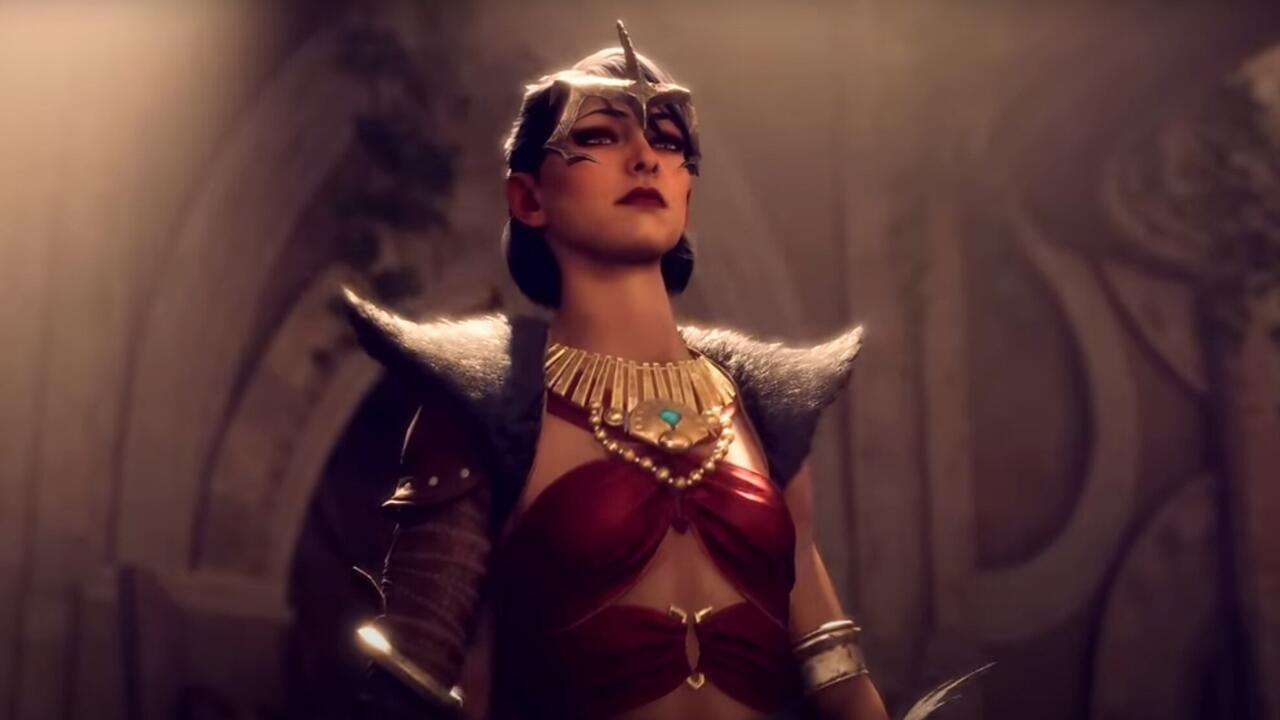
This is the second time I’ve seen this location and I still find it to be visually arresting, especially for Dragon Age. Previous games have looked good in their own ways, but Veilguard has more of a flare to its aesthetic. It’s cleaner but also uses vibrant colors–a nice change from the dusty palette of Inquisition. All of it also has an otherworldly and magical feel to it. Minrathous, for example, is unmistakably a metropolitan city with towering buildings, illuminated shop signs, and bustling streets, but the ordinary is given a fantastical twist. Raindrops bounce off of buildings, these imposing structures made of thick blocks of stone and sharp spires jutting into the sky–the dark and foreboding lighting illuminating a rustic tavern to look more like Dracula’s castle. The signage is made of wisps of magical energy that shimmer and pulse with a brilliant light as you pass by–magic is built into the fabric of society here. The people, meanwhile, live under the watchful eye of the Archon’s Palace, an ominous structure floating in the sky, from which spotlights beam down on the city below, giving the place a distinctly authoritarian vibe–typical of the Tevinter Imperium.
Though it may be a cliche, Minrathous has a strong sense of place and identity, which carries through to many of the other locations I saw–be it crumbling elven ruins reclaimed by nature or the Lighthouse, a kind of homebase that exists in the Fade, a metaphysical realm of primeval matter. Dragon Age: The Veilguard takes players to new parts of the world, some of which have been alluded to in previous games, books, or comics, while others are completely new. Either way, based on what I saw, BioWare is taking the opportunity to flex its creative muscles and create environments that are vivid and memorable to redefine what the world of Dragon Age can look like.
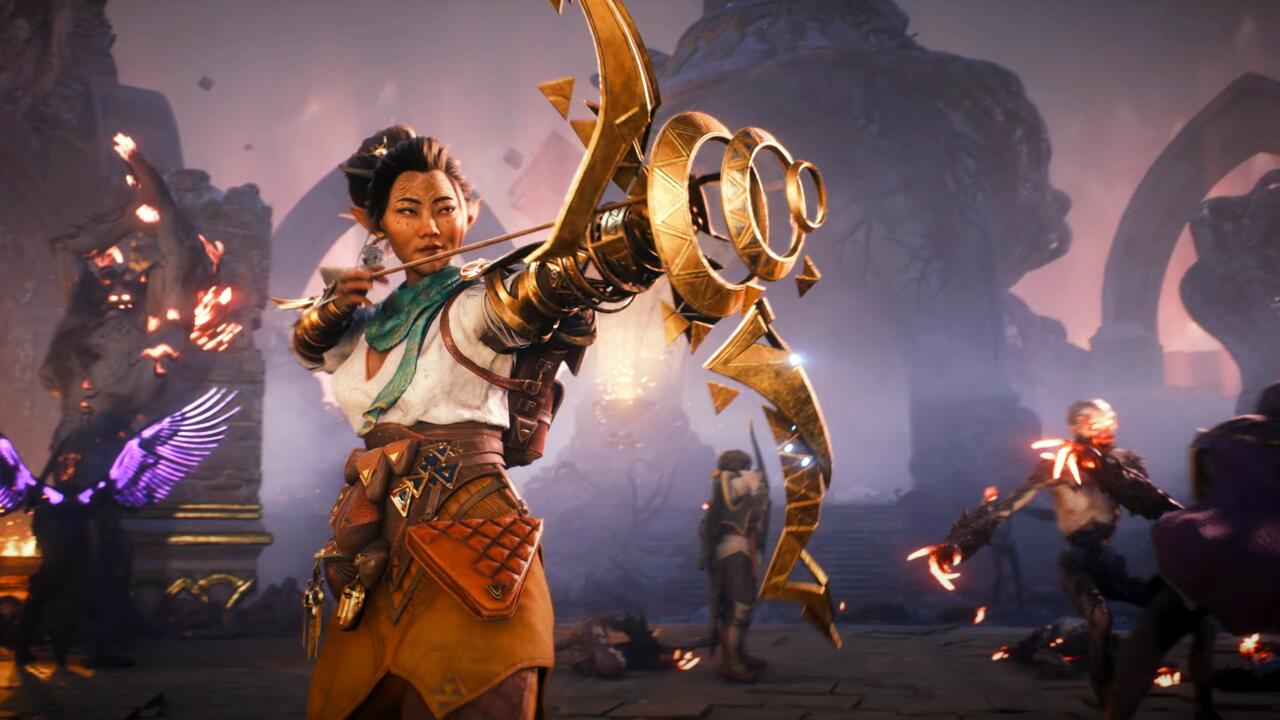
We’re hot on the heels of Solas and a magical tear in the sky opens up, signaling that he has begun whatever nasty ritual he has cooking. With the Veil between realms weakened, demons pour out onto the streets and cause havoc, making our path to reuniting with Lace Harding–a returning Dragon Age favorite… of mine specifically–a little more dramatic. Before long, my party of three was desperately fighting its way through Minrathous, felling demons, navigating precarious catwalks to get across the city, battling cultists, and evading capture, all while the city around us was being torn apart. It was surprisingly overwhelming for an opening of an RPG but that, according to Busche, is the point.
“Our philosophy on the prologue is we really feel like we’re making a contract with the player to show the intensity, the handcrafted nature of the experience, and how difficult the choices can be,” she explained. “And also we wanted to make sure that whether you’re a long-term fan or a first-timer in Dragon Age, that it immediately felt like you were making a difference–that you’re part of this expansive world of Thedas.”
“The thing I love about the prologue is it’s so fast-paced as soon as you get into it,” added Jen Cheverie, producer on The Veilguard. “You’re right in the action, you’re right in the story, you’re right in the world.”
You need a javascript enabled browser to watch videos.
Who Would You Romance? Dragon Age: The Veilguard
Please use a html5 video capable browser to watch videos.
This video has an invalid file format.
Sorry, but you can’t access this content!
Please enter your date of birth to view this video
By clicking ‘enter’, you agree to GameSpot’s
Terms of Use and Privacy Policy
Throwing the player into the thick of things is something that another BioWare game is notable, and beloved, for doing: Mass Effect 2. The opening of the studio’s sci-fi sequel was similarly dramatic, with the sudden destruction of the Normandy and death of Shepard making its opening moments feel like a climax more than an intro. More importantly, it’s a far cry from Dragon Age: Inquisition, which effectively trapped players in a forgettable location to do a series of tedious recruitment missions and dull fetch quests. And much like the start of Mass Effect 2–a poignant moment of Shepard’s gasping for air as they slowly float off into space that has stuck with me–I had this feeling while playing through the opening of The Veilguard that I was about to experience something special. While I can’t commit to saying that The Veilguard will match Mass Effect 2’s quality, I felt something akin to the same excitement playing Mass Effect 2 during my hands-on.
Later in the preview, I navigated through some ruins to find an Eluvian, effectively a doorway to another place that Solas has been utilizing to get around. It took me to The Arlathan Forest, where I found Solas conducting a ritual by generating so much power that it made the land around him tremor. Buildings around him were being sucked into the air; their destroyed remains twisting and swirling as the elven magic gathered around the Dread Wolf.
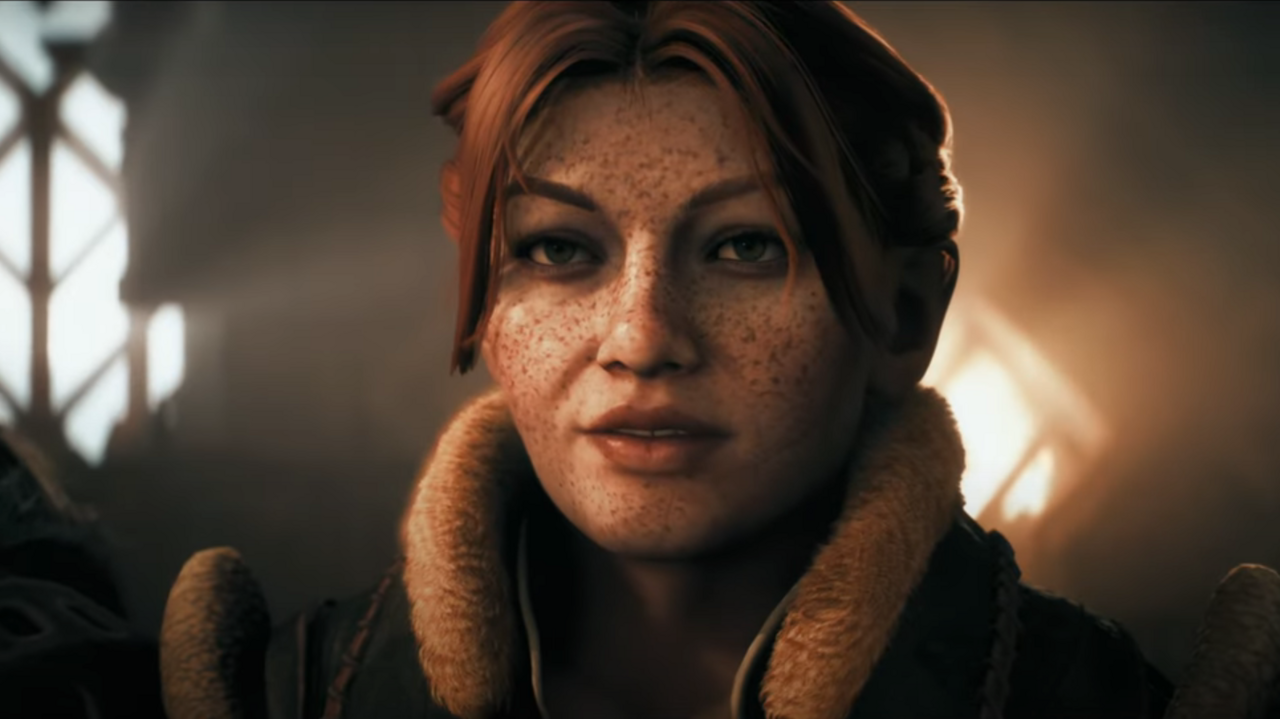

In the deciding moment, Varric announced that he was going to approach Solas and attempt to reason with him; to present him with another option other than the one he believes will undo his mistakes. It’s a risky gambit that, ultimately, was my call to pursue. I could choose to tell Varric that his plan was a mistake or to believe and trust in him–an easy, lightweight decision to get the old play-your-way gears rolling, I thought. I opted to let the power of friendship guide us which, devastatingly, earned Lace Harding’s disapproval.
Varric reunites with his former friend and the way it played out was the perfect encapsulation of what BioWare does best: use choice and consequence, strong writing, memorable performances, and a little bit of emotional manipulation to make players feel like the author of their own story, as opposed to the agent of another’s.
As Rook, Harding, and Neve battled demons to buy time, Varric approaches Solas and calls out to him, “Chuckles. Hope I’m not interrupting”–the name being a callback to his friendly jabs in Inquisition. Solas turns to meet whomever has approached him and for just a second there’s an expression on his face that was so disarming. It’s the face of someone recognising a friend they care about, recalling their history together, and realizing what he stands to lose, and may need to sacrifice. For a split second, there’s a vulnerability that Solas has so rarely expressed but longtime fans know is there. It’s an expertly crafted moment that is built on hundreds of hours spent in the world of Dragon Age and with Solas specifically that makes you think, once again, “I can fix him.”
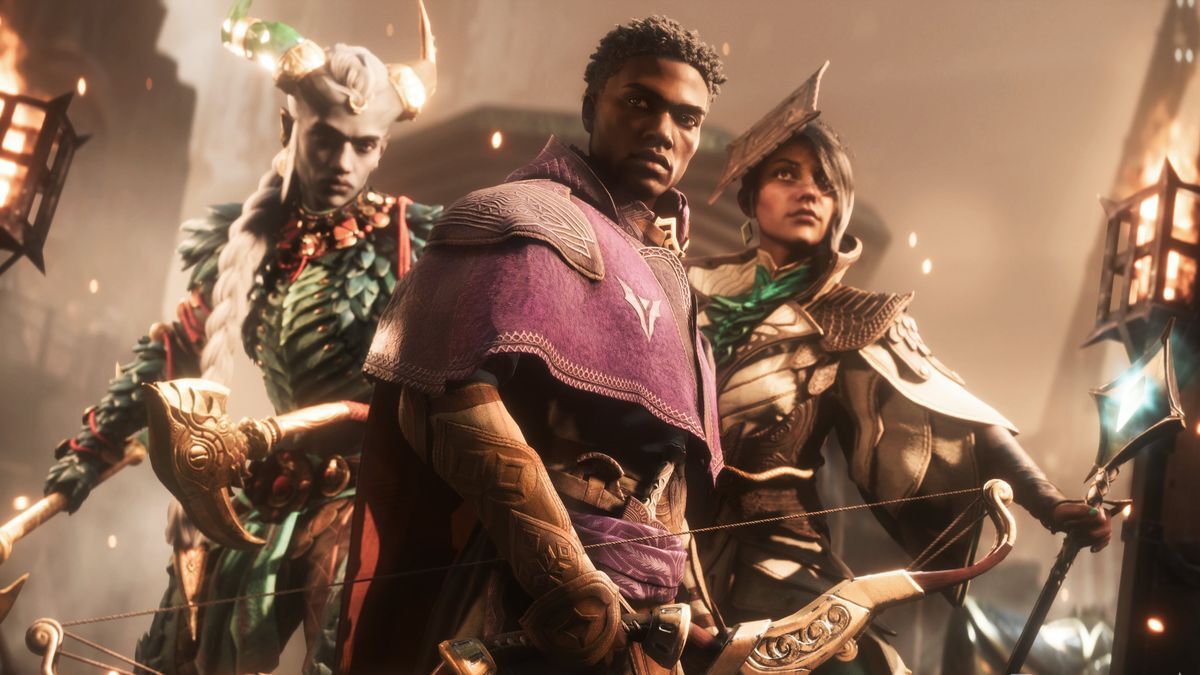

There were multiple moments like these, which I won’t spoil, but they were the strongest indication that BioWare was on the right track, and the gutsy, high-octane execution felt like a statement that they know it too. That moment was the game recalling a deeply personal connection between the player and the characters, and between the characters themselves, and leveraging all that for an impactful storytelling moment.
Later in the demo I ventured to Antiva–basically the Italy of Thedas; known for its wine, boats on canals, and general opulence. There, I was to meet with Caterina Dellamorte, First Talon of the Crows, who is believed to know of someone powerful enough to bring blood mages and Venatori to their knees; someone who would be especially handy to have at your side when attempting to defeat two ancient blighted mages come elven gods that are now terrorizing post-Solas ritual-gone-wrong Thedas. Said man is Lucanis, Caterina’s grandson, also known as the Demon of Vyrantium. Basically, he’s a powerful, badass, and cool dude. But he’s also dead. Kinda.
Caterina’s big secret is she believes the body of her grandson isn’t actually him and has instead been made to look like him with blood magic. And so begins a quest to free Lucanis, hopefully to return him to his grandmother and earn her approval so she lets her god-killing grandson join the gang. You could think of it as a kind of… loyalty mission.
You need a javascript enabled browser to watch videos.
Dragon Age: The Veilguard | Official 20 Minute Gameplay Reveal
Please use a html5 video capable browser to watch videos.
This video has an invalid file format.
Sorry, but you can’t access this content!
Please enter your date of birth to view this video
By clicking ‘enter’, you agree to GameSpot’s
Terms of Use and Privacy Policy
“While there are some differences, comparing it to say the [Mass Effect 2 and 3] loyalty missions–it’s not dissimilar,” Busche explained. “These are very, very personalized adventures. Sometimes you’re helping [characters] solve mysteries. Sometimes they’re just moments of deep connection. Not even combat at times. But they play out over many missions [and] moments. You’ll help each of the companions make some [choices], sometimes pretty heart-wrenching choices. And what I love is–and all the props to the writing team–how these arcs feel very personal to the companions, but also thread back through the main narrative of the game.”
Returning to my decision to try and reason with Solas, knowing the personal stakes Varric has is what pushed me to trust in him and let him handle it the way he believed was best. For me, a returning Dragon Age player, that decision had the emotional weight of an entire previous game’s journey and character arcs behind it, so watching as Solas plunged a knife into Varric’s chest was one of those gut-wrenching moments that made me freeze for a second of guilt and shame. More importantly, it was quintessentially BioWare; a battered and bloody Duncan looking up at the lit beacon as an axe came down on him in Dragon Age Origins; or Mordin matter-of-factly saying, “Had to be me, someone else might have got it wrong” in Mass Effect 3.
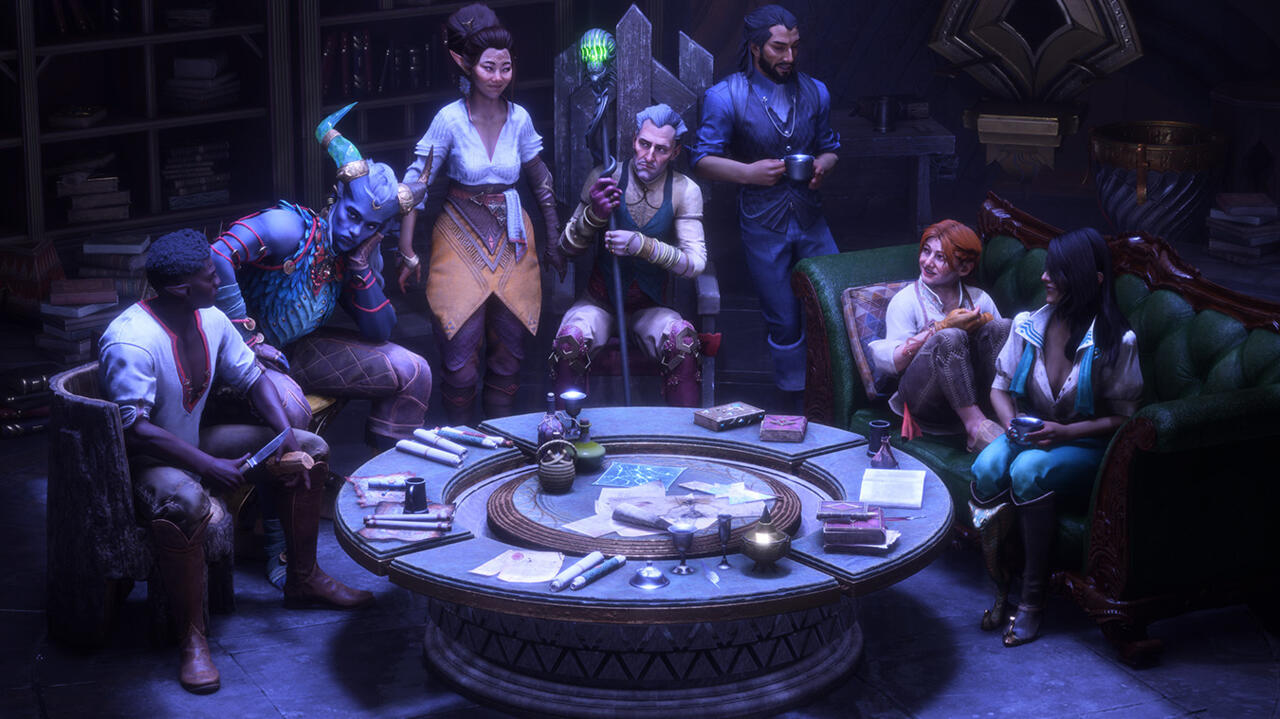

“When we look back at Dragon Age and Mass Effect, what we see are those smaller, more intimate choices that can really resonate,” Busche said. “We see political power-shifting [and] choices that resonate. We see the impact on the world. We see life and death. We see heartbreak. For us, what we knew is that to be an authentic BioWare game, we needed to run the full gamut of these choices. How and when they show up, I think [it will] keep players on their toes. I’m envious of players during their first playthrough to go in blind and experience some of these decision points … That’s what Dragon Age is all about.”
That is what Dragon Age is all about. And watching a despondent Lace Harding lamenting her inability to make a difference, despite proving herself as a capable lead scout for the Inquisition and holding her ground in battle, made me feel like I needed to see her entire arc, because I want to see her regain her sense of self. And as far as BioWare games go, is there a better sign than that?
The answer is yes, there is. Specifically when it comes to the meat-and-potatoes gameplay. By BioWare’s own admission, Dragon Age is a franchise that is constantly morphing with every new entry, but it feels like BioWare has achieved the fine balance between exciting combat where players are actively engaging in moment-to-moment skirmishes and the more considered, tactical, CRPG-elements of old.
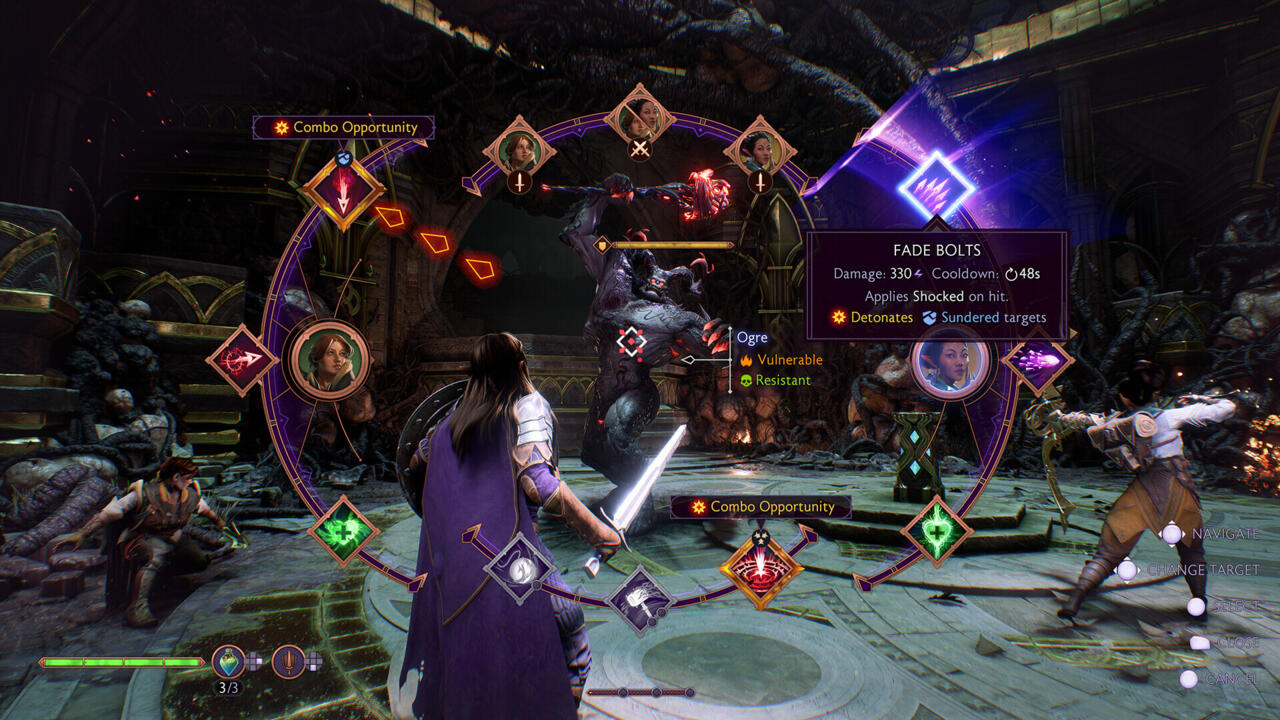

Although pulling up a radial menu and selecting abilities for companions is an important part of the combat system, overall it felt it leaned more in the direction of an action game. This is largely due to the game’s responsiveness and speed. I opted to play as a rogue, so I was running around with dual blades chaining light attacks together and swiftly cutting down enemies. It felt more like an action game, largely due to a slight stickiness in targeting enemies and exaggerated movements to close the distance between Rook and the enemy. While it’s not quite Batman gliding across a prison courtyard to clock a goon in the chin, it does have that sense of effortlessness when moving around a battlefield. When I wasn’t on the offense, I was making use of my dash to get out of the way of incoming attacks and space myself better, or tanking damage by holding my ground and blocking. Much to my pleasure, there’s also a parry mechanic that requires precise timing and, should you pull it off, the enemy is slowed and you have an opening to counteract.
The real juice, however, is in the abilities and specializations. As a rogue, my attacks generated momentum when they are uninterrupted. That can then be spent on abilities such as Static Strikes, which fires two bolts of lightning that travel forward and deal damage independently. I could quickfire my bow to apply pressure to enemies or hold down the trigger on the controller for a more precise shot that does extra damage–both provide me with good and reliable ranged options, since arrows automatically replenish over time.
You need a javascript enabled browser to watch videos.
Dragon Age: The Veilguard Won’t Leave New Players Behind
Please use a html5 video capable browser to watch videos.
This video has an invalid file format.
Sorry, but you can’t access this content!
Please enter your date of birth to view this video
By clicking ‘enter’, you agree to GameSpot’s
Terms of Use and Privacy Policy
Each class also has specializations that they can spec into to unlock further combat depth. The rogue, for example, can pick between Duelist, which excels in close-quarters combat by chaining together blows and dancing around the battlefield; Saboteur, a swashbuckler that uses explosives and other gadgets to hurt enemies or exert control over the battlefield; or Veil Ranger, which is focused on doing long-range, charged shots that are precise and powerful. While some of the unlocks under these specializations are stat boosts and buffs, others can be game-changing abilities that make a character play completely differently than what you’d expect and can make for some creative combinations with companions. A Veil Ranger, for example, is able to use weird ancient relics to adopt an experimental style of fighting. It has an ultimate ability called Twin Gifts of Arlathan, which throws two relic fragments that are entangled and will very quickly bounce between targets doing damage.
As a mage, I was able to fire off elemental spells from a distance, but I could also launch a sustained beam of energy to quickly whittle away shields and make enemies more vulnerable. But, in a tight spot, I was able to bust out a knife and get to stabbing, while also using a floating elemental orb to imbue it with magical power. The switch between the staff-wielding mage and mage-with-a-damn-knife is instant and can be done during combat encounters as the player chooses.
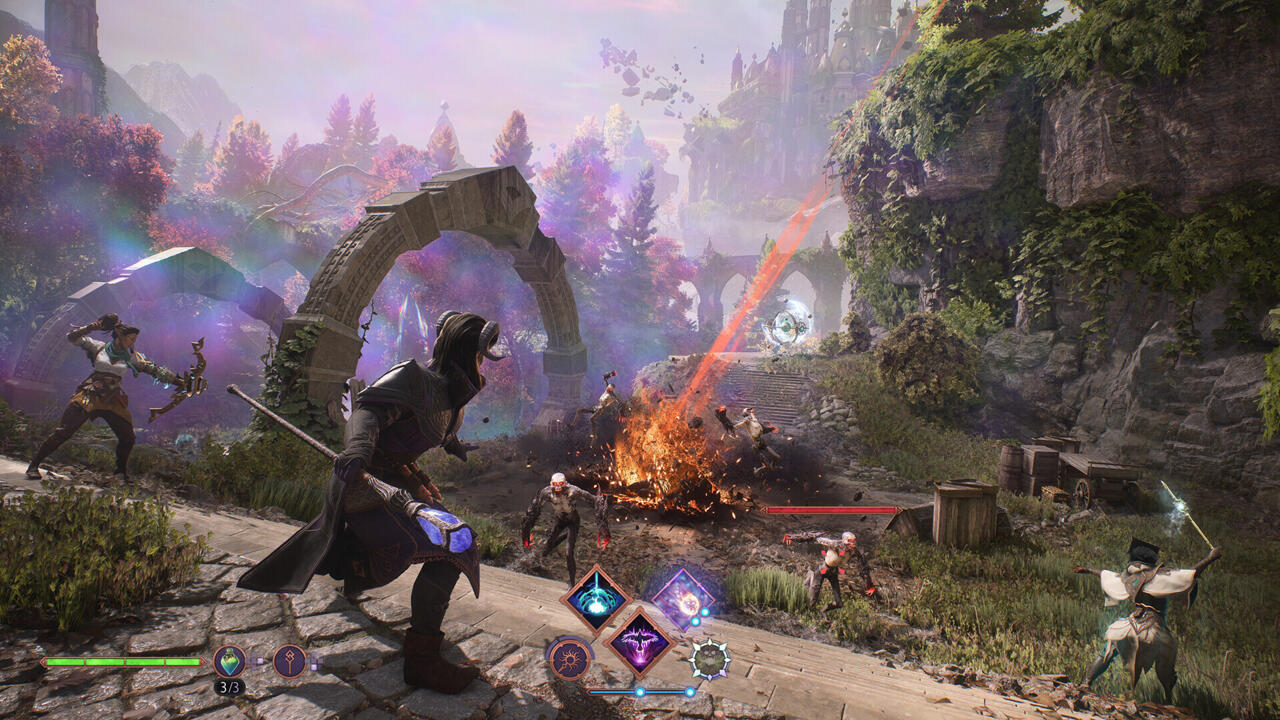

This is true for other classes too–that means that there’s basically two styles of each class available to the player at any given moment and that’s all without considering the three different specializations each class has. Combine that with the ability to have companions freeze enemies in place, launch devastating physical strikes, or follow you up with their own offense-based spells, and you’ve got a pretty satisfying variety for combat. But Veilguard also has designated combinations between Rook and companions that are denoted when the ability wheel is brought up. Use two combo-able abilities and you’ll do much greater damage with a flashy attack that can sometimes also leave enemies suffering from further ailments.
Sadly, I wasn’t able to really dig deep into it all and figure out the various options for other classes, but I can say that having a rogue that does necrotic damage with blades and can also place a turret to provide extra supporting firepower didn’t get boring for the many hours I employed that tactic. And neither did the very cinematic finishing moves that would occasionally punctuate the end of a battle.
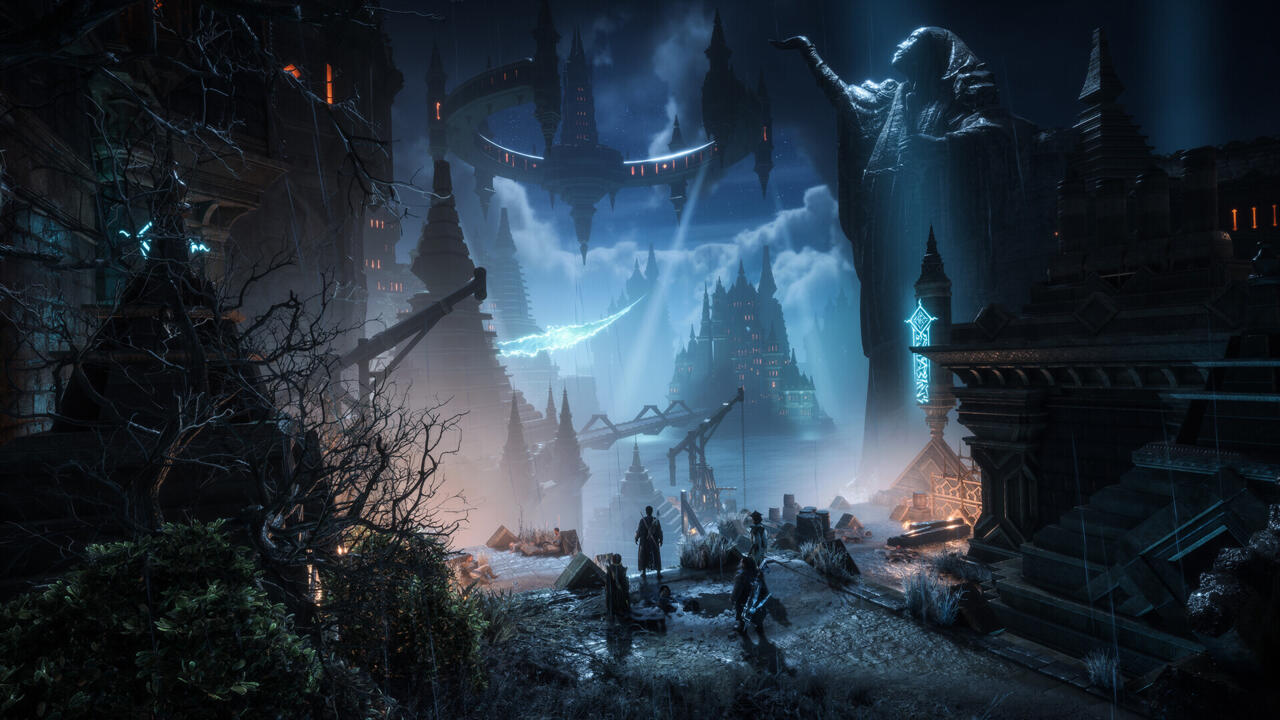

“We know Dragon Age has always reinvented itself in terms of how it approaches new combat systems game over game. And what that’s meant is that we have an incredibly diverse set of players in terms of their experience, their motivations, their expectations,” explained Busche. “We wanted to design a combat system that was high-fidelity. It felt fluid. It felt like you had a presence in the world, you were in control of your character. But also tapped into some of those core tenets of past Dragon Age titles.
“The throughline is always the pause-and-play, deep tactical layer. We’re quite proud of how that layers on top of that really fluid moment-to-moment gameplay. And then borrowing fan-favorite mechanics, looking back and respecting the past like the swapping weapon sets mid-combat, being directly inspired from Origins, or the pacing and intensity of Dragon Age II–we draw a lot of inspiration from that.”
Dragon Age II, though it may not hold the highest regard among fans, has clearly been a major influence when it comes to pacing and intensity of combat.
You need a javascript enabled browser to watch videos.
Dragon Age: The Veilguard | High-Level Combat Gameplay Breakdown Parts 1-4 Trailer
Please use a html5 video capable browser to watch videos.
This video has an invalid file format.
Sorry, but you can’t access this content!
Please enter your date of birth to view this video
By clicking ‘enter’, you agree to GameSpot’s
Terms of Use and Privacy Policy
“I love the pace of the combat fluidity in Dragon Age II,” said Cheverie. “I think that’s something that just feels so good as I’m playing through Veilguard. I just finished a playthrough with a mage and I went spellblade, so I’m basically a warrior-mage getting up in enemies’ faces and have a big burning ball of destruction, which is really fun when you’re using shortcuts to fire off abilities quickly and to shift commands to your companions so that they can combo. But as I was playing through the game and getting into some of the heavier hitting fights and started to feel the pressure and getting a little bit like, ‘Uh-oh, I got to take a breather,’ I was able to bring up that ability wheel. And it’s kind of like you have a team huddle with your companions and you figure out what to do and which ability to choose to control the crowd a little bit more and relieve the pressure.”
In many cases, combat can feel like a means to an end; the thing you need to do to get to the conversations and decision-making moments. But in my time with Veilguard, combat was the thing I most wanted to engage with. The specializations feel like classes unto themselves, and I was eager to figure out the places I could take them when factoring in weapons and armor, which can also impact playstyles meaningfully.
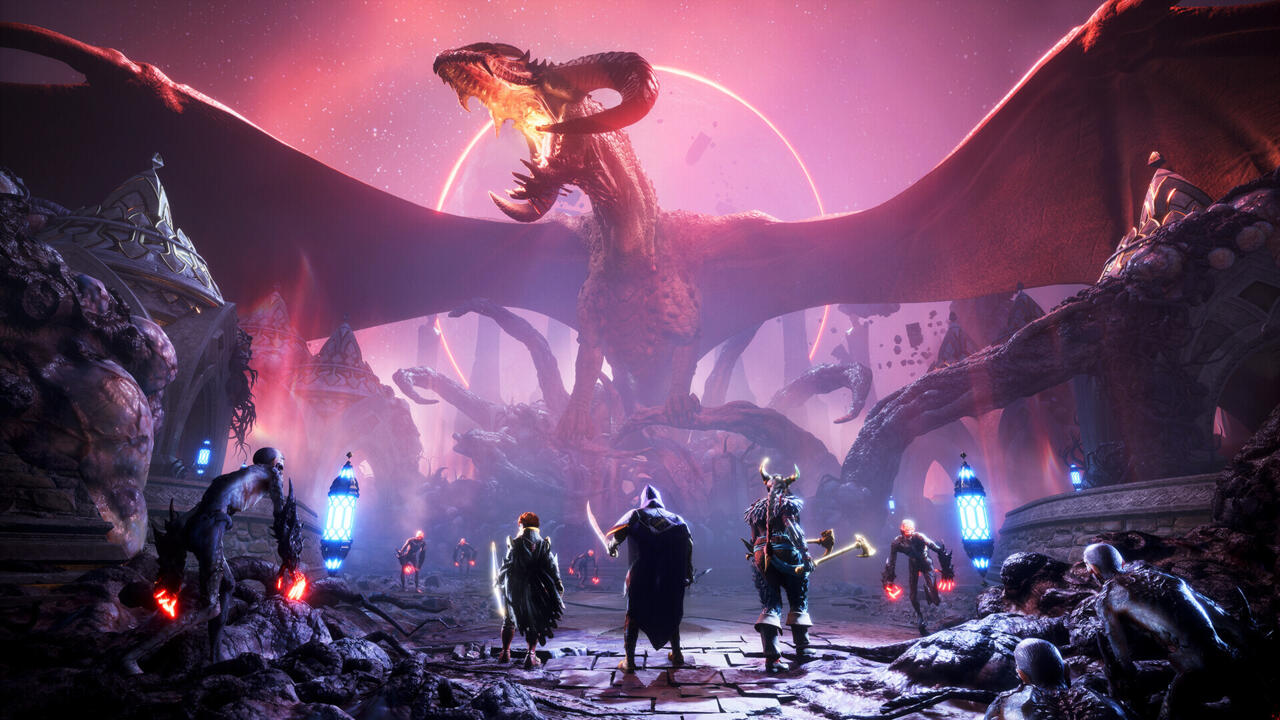

And there’s so much more to The Veilguard: the Lighthouse, where you can spend time with other characters and deepen bonds while getting more insight into the history of Solas, elaborate side quests that unlock new areas of Thedas to explore and can reveal new sides to companions that they hadn’t yet shown, and, of course, there’s the ability to flirt with anyone (and everyone, this time). You can woo them with gifts, or watch them fall in love with each other while you go about your business.
On paper, it can seem like The Veilguard might be doing too much, but in what I played, there was a focus and cohesion between everything; nothing felt superfluous. One of the decisions that I was happy to see work is the switch from open-world to a mission-based structure. BioWare seems to have pulled this off without making the world of Thedas feel any smaller. Instead, Rook and their companions venture out to the far corners of the world from the Crossroads, where a floating, ethereal boat operated by a mysterious Charon-like figure will ferry you to where you need to be. And those locations still have a grandeur to them; open enough to get lost and explore, but not so much that it feels like you’re trudging through nothing for lengthy periods of time.
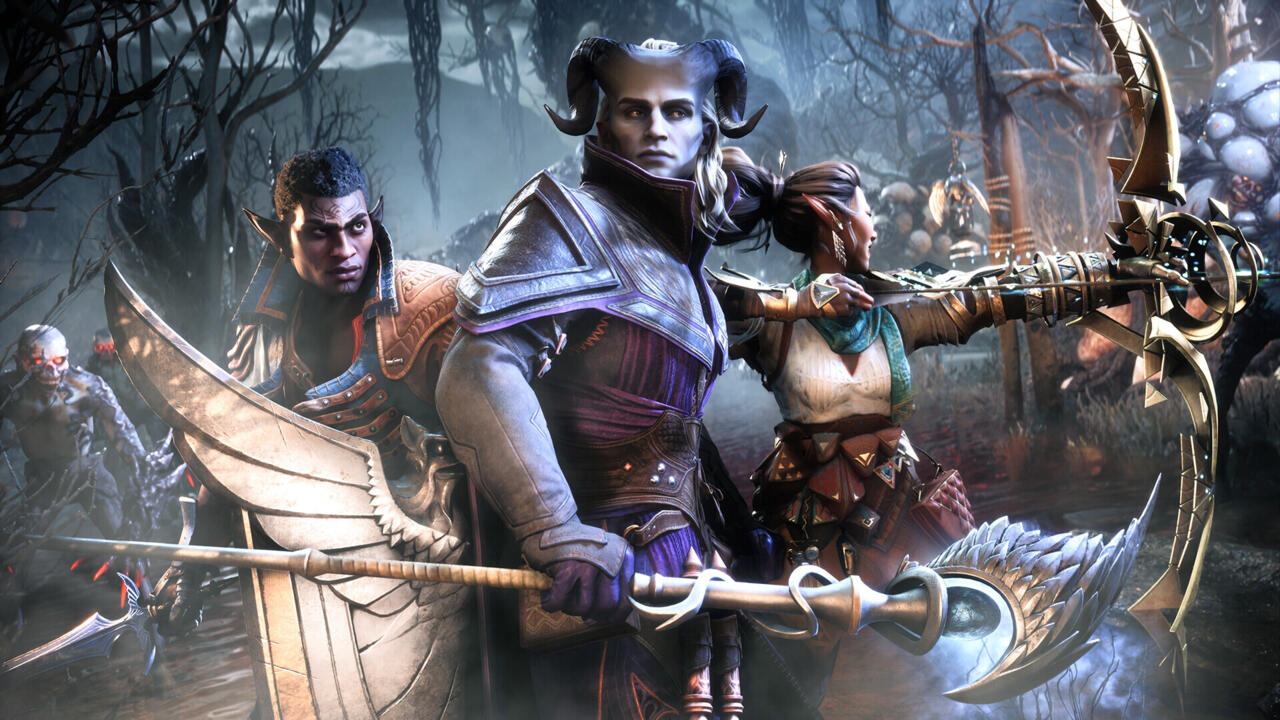

It all goes back to that sense of confidence that I mentioned. Dragon Age: Inquisition is a game I love, but can also recognize as being very messy, often poorly paced, and occasionally a bit of a bore to play. The disparate ideas and uneven execution made me feel like it didn’t have a clear direction. Veilguard, from what I played, came across as the complete opposite; a game that looks to have found a strong identity, established clear objectives, and built around the core principles that elevated BioWare to the top of the role-playing genre.
I came away from my hands-on with Dragon Age: The Veilguard desperate to play more; thinking to myself, “BioWare might be back.” As for what the game could mean for the future of the studio and its other projects, Busche said her priority was honoring Dragon Age’s legacy above all else.
“I want to approach it with humility. I will tell you the thing that I think about more than any other is honoring the legacy of what’s come before. This is an opportunity to expand this world, this rich tapestry of lore and people in a way that really affects people’s lives. So when I think about what’s at stake and what this game means to fans, I approach it with a sense of reverence for what came before. I really want people to see themselves in this game. I want them talking about this for the next 10 years and to live up to that standard.
“And I think I feel it in the team. A game like this, it really is a reflection of the people who have made it. And that commitment to it being an offline, fully complete, authentic game, that’s really driven and empowered the team to tap into their deepest creative energies. It’s truly a work of love.”
 Print
Print


